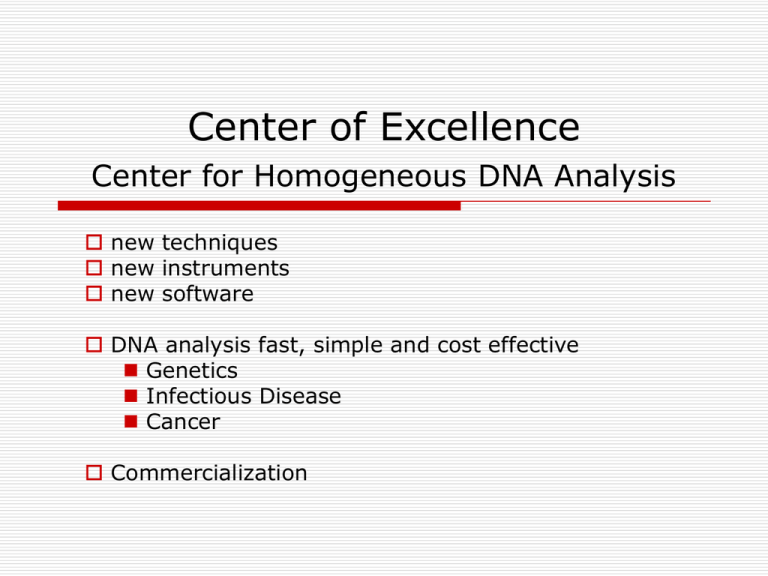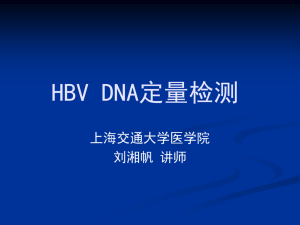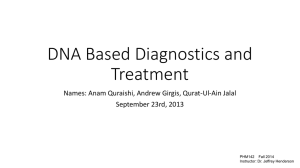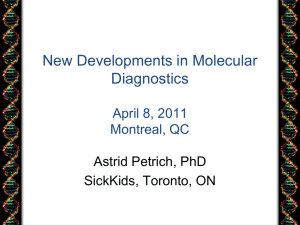Document
advertisement

Center of Excellence Center for Homogeneous DNA Analysis new techniques new instruments new software DNA analysis fast, simple and cost effective Genetics Infectious Disease Cancer Commercialization Background 1990s to present: Homogeneous DNA amplification and analyses Probes or dyes are added prior to PCR Focus on melting curve analysis 1997: Two “adjacent hybridization probes” 2000: Single hybridization probe 2003: Unlabeled probe 2003: Amplicon melting Hybridization Probe Formats Adjacent Unlabeled Single Hybridization Amplicon Probes Probes as (Simple Probes (LCGreen) the Probe Probes) (HybProbes) First year of COE - Achievements Instruments and Reagents Development of method to scan PCR products for unknown mutations, licensed to Utah company Reagents and instrument rights were licensed to IT, Inc HR-1TM and LCGreenTMI available in US Distributors in Japan, Italy, and Korea established First year of COE -Achievements Applications Mutation Scanning Software HLA Matching Unlabeled Probe Genotyping Amplicon melting - SNPs Mutation Scanning Use of a DNA toolbox as a model system for mutation scanning Highsmith et al., Electrophoresis (1999), 20: 188-1194 Constructed plasmids of 40%, 50%, and 60% GC content with A, C, G, or T at one position PCR primers on each side spaced 50 bp apart: X Mutation Scanning - Toolbox This data represents 1248 different calls in the Toolbox constructs Mutation Scanning - Toolbox Mutation Scanning - Toolbox Mutation Scanning - Toolbox Normalized and temperature shifted melting profiles Dependence of area difference on product length 30 Area Difference 25 20 15 10 5 0 70 100 150 200 250 300 350 Product Length (bp) 400 450 550 First year of COE - Achievements Software Automatic melting curve classification (U-3703) Primer design software for SNP analysis (SNPWizard U-3701) Primer design software for exon analysis (ExonWizard U-3702) Logistic quantification of real-time PCR (U-3704) Software – Demonstrations Genotype clustering of highresolution melting data Web SNPWizard Spiking animation for genotyping Genome-wide SNP nearest neighbor frequencies Software DNA duplex melting based on nearest-neighbor thermodynamic theory Currently available estimates are based on non-PCR conditions Determination of nearest-neighbor parameters via high resolution melting under PCR conditions Development of a software suite of programs for primer and probe design to simplify SNP typing, exon analysis and clinical assay design to support novel techniques Initial posting of programs on academic server: DNAWizards.path.utah.edu Software –Methods Increase the precision of Tm estimation to +/- 0.5C Include parameters under PCR conditions, such as: Fluorescent labels DsDNA dyes Product concentration Mg++, K+ and Tris+ effects DNAWizards.path.utah.edu DNAWizards site hosts Remotely controlled DNA analysis software SNPWizard Downloadable data Updated genomic SNP data Publications and supplementary materials Optimal spiking visualization First year of COE - Achievements HLA Matching Determining HLA Genotypic Identity Among Siblings Siblings are the best first candidates for organ donation. They are most likely to share common HLA alleles. Current HLA Typing Methods: Serotyping and DNA sequencing Most widely used Expensive Requires several days for completion High-resolution melting is a simple way to establish genotypic identity at polymorphic loci. HLA Inheritance A3 A1 A1-A3 A2 A2-A3 A4 A1-A4 A2-A4 CEPH Family UT1331 Melting Curve of HLA-A Exon 2 Sibling Genotypes HLA Locus HLA Class Genotype 1 Genotype 2 Genotype Genotype 3 4 A I 9, 10, 16 4, 7 8 3, 5, 6, 11, 17 B I 9, 10, 16 4, 7 8 3, 5, 6, 11, 17 C I 9, 10, 16 4, 7 8 3, 5, 6, 11, 17 First year of COE - Achievements Genotyping with Unlabeled Probes No fluorescently-labeled probes required Uses simple 3’-Blocked oligonucleotides Asymmetric PCR LCGreen I Lower Cost Greater probe stability Greater flexibility Asymmetric PCR Amplicon and Probe Peaks with Asymmetric PCR Mismatch-detection of Homozygous Template (LCGreen I) Mismatch-detection of Heterozygous Template (LCGreen I) Mismatch-detection of Heterozygous Template (Sybr Green I) Effect of Unlabeled Probe Length (LCGreen I) Genotyping of [delta]F508 (LCGreen I) 5 [delta]F508 hom Wild type -dF/dT 4 [delta]F508 het 3 2 1 0 60 Temperature (°C) 70 SNP Genotyping with LCGreen I First year of COE - Achievements Amplicon melting - SNPs Successful genotyping of all possible SNPs shown with plasmids. Demonstrated on clinically significant mutations. Melting Curves Homozygote Amplification One Homoduplex T A Temperature Melting Curves Heterozygote Amplification Two Heteroduplexes Observed Combination of 4 Duplexes Two Homoduplexes T A C A C G T G Temperature Small Amplicon Primer Design Primers are designed to be as close as possible to the SNP site The sequence of the primers must be checked for primer-primer dimer formation Forward Primer 5’ 3’ A T 3’ 5’ Reverse Primer Engineered SNP pBR322 Plasmids Clinical Samples Spiking Experiments Comparison of Methods for RealTime SNP Typing First year of COE - Achievements Commercial 20 systems have been sold w/ gross revenue of $210,000 Six new jobs created, w/ average salary of $56,000 Technology Rights U of U has 13 issued US patents in addition to foreign counterparts About 13 further patents pending Some technology rights have been licensed to Utah companies Those NOT licensed as of yet: Homogeneous sequencing and repeat typing (U-3601) [optioned to IT, Inc through 7-2004] Integrated primer synthesis and target amplification on arrays (U3570) [optioned to IT, Inc through 5-2004] Homogeneous multiplex hybridization by color and Tm (US pat. #6,772,156) Simultaneous screening and identification of sequence alterations form amplified target (US pat. pending #2002-0142300) SNPWizard (U-3701) ExonWizard (U-3702) Automatic clustering and classification of homozygotes and heterozygotes by high-resolution melting curve similarity (U-3703) Logistic quantification of initial copy number from the plateau height, linear growth rate, and maximum second derivative of PCR amplification curves (U-3704) Future Areas of Technology Development Methods for homogeneous repeat typing and sequencing Software for DNA analysis with the objective of spinning off “DNAWizards.com” Developing a highly parallel hardware platform for real-time PCR an melting analysis in conjunction with proposed new COE by Dr. Bruce Gale (UU engineering) Homogeneous Repeat Typing and Sequencing – Methods Chain extension with dideoxynucleotide termination High-resolution melting post PCR for direct Tm determination Example: CA repeat determination: Amplification with dCTP, dATP and ddGTP. Amplification stops at first G after CA repeat. Melting peak will indicate length of repeat. Method works in an synthetic oligonucleotide system (see figure to right) Homogeneous Repeat Typing and Sequencing – Experiments What repeat lengths can be distinguished? Can heterozygotes be easily identified? What about small fractions of a repeat allele, as might be seen in cancer? What should the primer’s GC content be compared to the repeat’s GC content? Homogeneous Repeat Typing and Sequencing – Challenges Asymmetric PCR needs to be coupled to cycle sequencing (closed tube!) To separate the PCR reactions from the sequencing reagents, the sequencing reagents are added on top of an oil barrier. After amplification, a centrifugation step will mix reagents and sequencing can start. (described for nested PCR, J. Clin. Virol. 2001, 20:7175) In a completely homogenous reaction, the use of two different polymerase can accomplish amplification and sequencing at the same time (described in Nucleic Acids Res. 2003, 31:e121) Digestion with lambda exonuclease can eliminate one strand after PCR if one primer is 5’phosphorylated. Homogeneous Repeat Typing and Sequencing – Commercialization Plan Commercial partner or spin-off company will provide generic research reagents ($0.5/assay) 10 x dye optimized dye/buffer combination freeze dried PCR master mixes Software for repeat typing ($1,000 per license) Software for sequencing ($1,000 per license) Analyte Specific Reagents (ASRs) sold to diagnostic laboratories ($20-40/assay). HCV genotyping bacterial identification by rDNA Future DNAWizards.com Software Goals User-friendly DNA manipulation/visualization Integrated platform from design to analysis Projects Tm prediction under PCR conditions Primer design for SNP typing Primers/probes for exon mutation scanning Primers/probes for allele-differentiation by Tm Automatic normalization and genotype clustering Automatic genotyping by curve classification PCR target quantification DNAWizards commercialization Software purchase/upgrades Fee per use Contract design/analysis User support and education Oligonucleotide synthesis partnership Clinical lab partnership Software – Commercialization Plan DNAWizards.com, a software and service enterprise will provide contract services and distribution of software and educational material. A bundled software package ($1,500) will include: TmWizard, free web trial, $200 software SNPWizard: free web trial, $25 custom design/assay, $200 software ExonWizard: free web trial, $100 custom design/gene, $300 software DxWizard: $100-$500 custom design/assay, $700 software CtWizard: free web trial, $200 software TypeWizard: free web trial, $100 software Arrays for Real-Time PCR – Objectives directing Methodology Determine feasibility of amplifying and monitoring PCR and HR-melting in 1-10 nl volumes There is no commercial array system for parallel real time PCR Closest competitor is ABI with their Prism 7900HT instrument Arrays for Real-Time PCR – Anticipated Problems Deposition of the primers in each compartment Microfluidic introduction of the sample/PCR master mix to all cells Sealing each compartment to prohibit intermixing Arrays for Real-Time PCR – Commercialization Plan Estimated price for the bare chips: $10 Estimated cost of analyte-specific chips will depend on the number of parallel reactions in the chip. i.e. 100 well chip (CF testing) costs $30 i.e. 300,000 well chip (human exon) costs $1,000 Instrument capable of PCR temperature cycling, real-time monitoring, and highresolution melting: $50,000 and $70,000 How COE will Demonstrate Value of New Technology Research publications Providing access to analytical software through DNAWizards.path.utah.edu Alpha-site testing at leading clinical diagnostic laboratories As well as domestic and foreign academic centers Further Considerations Out-licensing of newer technologies Formation of a new service/manufacturing company in Utah, which may or may not be independent of the new software company, DNAWizards.com Product sales and distribution is best done through regional distributors or alliance partner(s) Estimates Our methods will eliminate 95-99% of high-cost conventional DNA sequencing Global market for Center’s technology is ca $400 million (instruments plus reagents) Annual growth of 9 – 10% Annual revenue of $ 24 million (4% share) in 2008 Eventual financial independence from state Development of newer technologies from years two through five will further strengthen competitive advantage of high resolution melting Six additional new jobs created in year 2 Program Schedule Competitive Analysis -Homogeneous Repeat Typing and Sequencing Competitive Analysis -Software There are over 30 oligonucleotide design web sites that offer free primer/probe design on-line Several are linked to oligonucleotide synthesis services Some are at least partly specific to a platform Software for SNP typing, exon analysis, repeat typing and sequencing based on melting temperature are not available Our techniques do not require probes and are less expensive Tm predictions will be more accurate than prior methods by an order of magnitude Competitive Analysis - Arrays for Real-Time PCR and HighResolution Melting Analysis There is presently no commercial array system for parallel real-time PCR Closest competitor: ABI with Prism 7900HT instrument $200/card, $2/assay, 1-2ul/assay Our system envisions 1-10nl/assay By flooding the system, highly parallel analysis on a genome-wide scale possible Market Analysis - Sequencing and Repeat Typing For clinical tests (HIV & HCV): 360,000 assays/year HLA sequencing: 25,000 assays/year Estimate for global market: 800,000 assays/year Market Analysis - Microarray Market Instrumentation estimated at $600 Million Bioinformatics estimated at $110 Million Affymetrix (50% of market) with 20% annual growth in sales 970 microarray analysis systems installed as of Jan 2004 Economic Impact Create, attract and retain highly skilled technical workforce Attract possible out-of-state investment to fund COE’s activities Provide opportunity for infusion of federal funds through SBIR, STTR, and ATP programs Attract visiting scholars for collaborative studies and international conferences COE could interface with clinical diagnostic labs, such as ARUP and Myriad Organizational Structure Program Coordination -Method Group Dr. Luming Zhou Rob Pryor (sr. lab. Technologist) Joshua Vandersteen (undergraduate) Matt Poulson (graduate Student) Dr. Gudrun Reed (sr. lab. Technologist) Will also provide Market Intelligence Measurable Milestones: Determine length and sequence dependence of melting analysis Obtain new parameters for Tm estimation under PCR and melting conditions Program Coordination -Software Group Dr. Bob Palais Ian Odell Allison Jarstad (undergrad) Measurable Milestones: Development of Math of DNA course at U of U Posting web versions of TmWizard SNPWizard ExonWizard DxWizard CtWizard TypeWizard Program Coordination -Array Group Dr. Bruce Gale Graduate Student (to be named) Measurable Milestones: Demonstrate 1-10nl PCR reactions on a micro-machined chip substrate Current and Pending Support Title Agency Dates Amount SNP Typing without Probes U of U Research Fund 7/3-6/05 $70,000 Fluorescent Nucleic Acid Techniques Idaho Technology 1/03-12/07 $1,652,000 Center for Homogeneous DNA Analysis State of Utah 7/03-6/04 $150,000 Homogeneous Mutation Scanning NIH STTR (Phase I and II) 7/04-12/06 $850,000 Integrated Amplification and Mutation Scanning NIH STTR (Phase I and II) 1/05-6/07 $850,000 Financial Plan Projects initiated in 2nd year are expected to break even during 4th year Licensing of homogeneous repeat typing and sequencing possibly to Idaho Technology, Inc. (matching funds) –or to Roche 4th and 5th year will focus more on market penetration Generic reagent and ASR revenue in 4th and 5th year will reach $2-3 Million/year Spin-off DNAWizard.com in 3rd year Chip platform will be ready for the market in last year of center operation With a 5% market share this would equal $40Million/year








